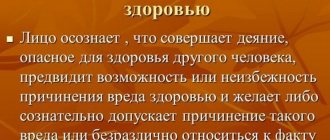ST 112 of the Criminal Code of the Russian Federation.
1. Intentional infliction of moderate harm to health, not dangerous to human life and not entailing the consequences specified in Article 111 of this Code, but causing long-term health disorder or significant permanent loss of general working capacity of less than one third, is punishable by restriction of freedom for a term of up to three years, or forced labor for a term of up to three years, or arrest for a term of up to six months, or imprisonment for a term of up to three years.
2. The same act committed: a) in relation to two or more persons; b) in relation to a person or his relatives in connection with the performance of official activities by this person or the performance of public duty; c) in relation to a minor or another person who is known to be in a helpless state by the perpetrator, as well as with special cruelty, humiliation or torture for the victim; d) by a group of persons, a group of persons by prior conspiracy or an organized group; e) for hooligan reasons; f) for reasons of political, ideological, racial, national or religious hatred or enmity, or for reasons of hatred or enmity towards any social group; g) has lost its force; h) with the use of weapons or objects used as weapons - is punishable by imprisonment for a term of up to five years.
Concept and signs of moderate health harm
Article 112 of the Criminal Code of the Russian Federation refers to the infliction of harm to health of moderate severity, not dangerous to the life of a citizen, but causing long-term health problems or a significant permanent loss of general ability to work by less than one third.
A crime committed by an attacker is an attack on the health of another person . And by harm we mean a violation of the anatomical integrity and physiological function of a citizen’s organs and tissues as a result of exposure to physical, chemical, biological and mental environmental factors.
Qualification of all crimes of medium gravity - articles of the Criminal Code of the Russian Federation related to crimes of medium gravity and punishment for them
Characteristic signs of moderate health harm are:
- There is no danger to life at the time of harm. That is, harm to health is caused that is not life-threatening.
- Absence of the consequences specified in Article 111 of the Criminal Code of the Russian Federation, which provides for liability for intentional infliction of grievous bodily harm. The signs of serious harm to health are listed in Part 1 of this article.
- Long-term health disorder. The victim temporarily loses his ability to work for 21 to 120 days.
- Or he has a significant permanent loss of total working capacity of less than one third. This sign will be determined by a forensic examination.
- Or a persistent loss of general ability to work from 10% to 30%, which is also established by a forensic medical examination.
One sign is enough, for example, a long-term health disorder, for the attacker to be prosecuted under Article 112 of the Criminal Code of the Russian Federation.
Causing moderate harm to health includes, for example, cracks and fractures of small bones, several ribs on one side, dislocations in small joints, persistent difficulty speaking, loss of a finger or toe, moderate concussion, etc.
To prove these versions, the defense chose the following tactics:
Establishment of individual psychological characteristics of personality and physical data.
From Ivan’s testimony it followed:
“that he was struck in the head. From this blow, Ivan hit the back of his head on the car body near the roof. After the blow he received, his perception was scattered, everything went dark in his eyes, he was in a state of prostration.”
Further, as part of the lawyer's survey, the following were interviewed: Ivan's wife, his former boss and current boss.
Ivan’s wife explained:
“that her husband is a calm, not hot-tempered person, reasonable by nature, avoids conflicts.”
From the explanations of Ivan’s former boss it follows:
“He knows Ivan as a kind, sympathetic, non-conflict person. He never saw Ivan in an angry, malicious state.”
From the explanations of the current boss, Ivan, it followed:
“Ivan is a very calm, balanced person; he does not tend to conflict, humiliate, or laugh at anyone. Ivan always thinks about his actions for the future, before doing anything, he thinks many times about the possible consequences, and makes sure that his decision is correct.”
By occupation, Ivan was a programmer. According to medical documents included in the case file, Ivan had a number of chronic diseases that did not allow him to be in good physical shape. Ivan’s physique is thin; Ivan has never been involved in combat sports or martial arts.
Through a lawyer's request, it was established that the man who struck Ivan had a military education. According to anthropometric data, he was taller than Ivan and larger in build, weight, and build.
Thanks to the establishment of the individual psychological characteristics of Ivan’s personality and physical data, comparing them with the anthropometric data of the man who hit him, taking into account his military education and special training, it was possible to conclude that in the situation that occurred, Ivan could hardly initiate a conflict with the person who is physically much stronger and older than him.
Application for a forensic psychological and psychiatric examination.
The reason for prescribing a forensic psychological and psychiatric examination is the behavior of the suspect/accused when committing the incriminated act: unexpectedness of actions, the appearance of previously unusual forms of behavior, as well as data on the conflict situation before the event.
The purpose of the examination is to establish in the suspect/accused the presence or absence of a temporary mental disorder (the competence of a psychiatrist-expert), physiological affect (a normal, but extremely strong emotional reaction) or other emotional states (the competence of a psychological expert) at the time of the commission of the incriminated act.
In order to establish these circumstances in relation to Ivan, it became necessary to conduct a comprehensive outpatient psychological and psychiatric examination in order to obtain answers to the following questions:
Was Ivan in a state of passion at the time of committing the act accused of him?
What is Ivan’s general psychological characteristics (temperament, character, inclinations, needs)?
What are Ivan’s individual psychological characteristics (characterological, emotional-volitional)? Did they have a significant influence on his behavior during the commission of the act charged with him?
Was Ivan, at the time of committing the act accused of him, in a state of heightened emotional tension caused by a traumatic situation?
Considering Ivan’s mental state, his individual psychological characteristics, as well as the circumstances of the case, could he accurately correlate his defensive actions with the objective requirements of the situation?
Conducting a psychophysiological study (polygraph test), filing a request for questioning of a polygraph examiner.
The use of a polygraph (lie detector) in the process of evidence in criminal cases is highly controversial. As a general rule, the conclusion based on the results of a polygraph test is not accepted as evidence in a criminal case, however, the opposite practice also exists. At the same time, one of the ways to legalize a polygraph conclusion is to interrogate the person who conducted the specified study as a specialist. In combination with a polygraph conclusion and an interrogation of a polygraph examiner, the chances that this conclusion will be taken into account increase. In addition, it is worth considering that even if the polygraph report is not regarded as evidence in the case, in any case it contains indicative information that may be valuable in the absence of other evidence.
In the case under consideration, the use of a polygraph was due to the fact that Ivan’s testimony and the testimony of the man who was injured were significantly different, and there was no other evidence with which to eliminate the contradictions.
As a result of the psychophysiological study, it was found that Ivan’s reactions to the questions asked were consistent with his answers about the events of bodily harm. Thus, it was established that Ivan’s testimony regarding the circumstances of the event was truthful. The conclusion of the psychophysiological study was added to the materials of the criminal case.
In order to establish the circumstances of the psychophysiological study, clarify the methods, equipment used by the specialist, the validity of the study and the conclusion reached, a request was made to interrogate the person who conducted the study as a specialist. In addition, a request was made to conduct a psychophysiological examination of the victim in order to establish the veracity of his testimony.
Application for a medical-forensic (situational) forensic examination.
During the investigation of the criminal case, two versions of the event were identified in terms of causing damage (the suspect's version and the victim's version). The versions presented by the suspect and the victim had contradictions in the following points:
The victim claimed that Ivan struck him first, only after that the victim hit Ivan in the face area. Ivan sets out a different sequence, and indicates that the infliction of damage with a knife occurred after a blow to his face, while the infliction of damage with a knife was unintentional, and became possible only as a result of the fact that the victim grabbed him with his hands in the chest area and tried to maintain balance Ivan grabbed the victim’s shoulders, thereby accidentally cutting his body in the neck area.
The victim claims that when he and Ivan took hold of the clothes, they moved around. Ivan claims that he did not grab the victim’s clothes and they stood still.
The victim claims that when he and Ivan grabbed each other’s clothes, they pushed each other and tried to throw each other to the ground. Ivan indicates that these actions did not occur, that he did not push or try to throw the victim to the ground.
Considering that the mechanism of formation of the injuries present to the victim is essential for the investigation of a criminal case, taking into account that the version presented by the suspect must be verified, the need arose to conduct a medical-forensic (situational) forensic examination, during which, with the participation of It is possible for a forensic physician to recreate the situation of the event and check the possibility of causing damage to the victim based on the version stated by the suspect, namely, to obtain answers to the following questions:
What is the mechanism of formation and localization of the injuries the victim has?
Could the injuries present to the victim have occurred under the circumstances stated by the suspect?
What is the mechanism of formation and localization of the damage present on the suspect?
Could the suspect’s injuries (contusion of the soft tissues of the face on the left in the projection of the cheekbone and bruise of the soft tissues of the occipital part of the head) occur under the circumstances described by the suspect?
Corpus delicti
We list the important features of the crime:
- The object is public relations that ensure the safety of the health of citizens.
- The objective side is expressed in the unlawful infliction of moderate harm to the health of another person through action or inaction with criminal consequences.
- A causal relationship must be established between the act and the consequence.
- The subject may be an individual who has reached 14 years of age at the time of the crime.
- The subjective side is characterized by intentional guilt. Intention can be direct or indirect. Most often, the intent here is vague (unspecified).
Please note that causing moderate harm to health differs from attempted murder and attempt to cause grievous harm to health (Article 105 and Article 111 of the Criminal Code of the Russian Federation).
The corpus delicti and the intent of the perpetrator are essential.
Attempt means the impossibility of completing one’s intention due to circumstances beyond the control of the attacker (intervention of third parties, active resistance of the victim, provision of medical care to the victim, etc.). Often the attempt is associated with serious harm to health.
Responsibility and punishment under Article 112 of the Criminal Code of the Russian Federation - intentionally, through negligence, in an accident
Responsibility for a crime under Art. 112 of the Criminal Code of the Russian Federation, begins at the age of 14.
In accordance with Part 1 of Article 112 of the Criminal Code of the Russian Federation, intentional infliction of moderate harm to health is punishable by:
- Restriction of freedom for up to 3 years.
- Or forced labor for the same period.
- Or arrest for up to six months.
- Or imprisonment for up to 3 years.
According to Part 2 of Article 112 of the Criminal Code of the Russian Federation, an attacker can be imprisoned for up to 5 years if the same act was committed:
- In relation to two or more persons.
- In relation to a person or his relatives in connection with the performance of official activities by this person or the performance of public duty.
- In relation to a minor or another person who is known to be in a helpless state by the perpetrator, as well as with special cruelty, humiliation or torture for the victim.
- A group of persons, a group of persons by prior conspiracy or an organized group.
- For hooligan reasons.
- For reasons of political, ideological, racial, national or religious hatred or enmity, or for reasons of hatred or enmity towards any social group.
- Using weapons or objects used as weapons.
When assigning punishment, courts take into account many circumstances, including what specific qualifying feature is imputed to the attacker , as well as the very circumstances of the crime committed.
Let us note some cases where moderate harm was caused to health:
- By negligence. Responsibility for this act was lifted in 2022; previously it was provided for by part 3.4 of Article 118 of the Criminal Code of the Russian Federation. Now, causing moderate harm to health through negligence is not criminally punishable. The attacker will be subject to civil liability. The victim can recover moral damages through the court.
- In case of a traffic accident. The attacker will also not be punished criminally, but will be brought to administrative responsibility under Part 2 of Article 12.24 of the Code of Administrative Offenses of the Russian Federation. For causing moderate harm in an accident, you may be deprived of your license or forced to pay a fine.
Other cases where the harm was caused intentionally will be considered under Article 112 of the Criminal Code of the Russian Federation.
Can they not be held criminally liable under Article 112 of the Criminal Code of the Russian Federation?
Under this article, reconciliation between the parties is possible, which means that the attacker can be released from criminal punishment. This right is enshrined in Article 76 of the Criminal Code of the Russian Federation and Article 25 of the Criminal Procedure Code of the Russian Federation .
But before the parties agree, the court will:
- Comprehensively investigate the nature and degree of public danger of the crime.
- Analyze all personal data of the defendant.
- Study all the circumstances of the case.
- Look at what actions were taken by the perpetrator to make amends for the harm caused by the crime.
In addition, when a decision is made, they will look at the victim, his financial situation, and especially whether pressure was put on him.
They will also take into account whether the decision corresponds to the goals of protecting the rights and interests of the victim, society and the state as a whole.
As practice shows, courts rarely award 5 years in prison. Usually this severe punishment applies to those who have committed a repeated crime, and a similar one. Citizens who have committed a crime of minor or moderate gravity for the first time, when reconciling with the victim and making amends for the harm caused, do not serve their sentence behind bars.
Victim's version:
The victim did not agree with the circumstances of the incident as stated by the suspect. The victim indicated that when he approached the car, Ivan got out of it, he began to talk to him, during the conversation the victim approached Ivan, after which they grabbed each other’s clothes, pushed, struggled, moved around, then the victim felt pain in the back area, and in response he punched Ivan in the face. Moving away from Ivan, the victim saw that he had a cut in the neck area. The victim indicated that he did not strike Ivan first; he struck only after Ivan cut him with a knife.







